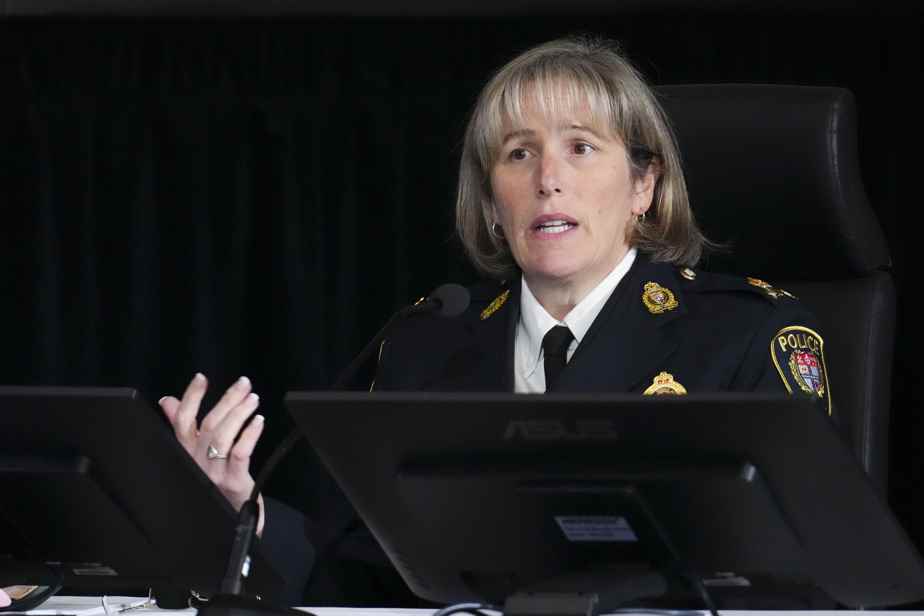(Ottawa) A first police operation targeting the Farfadaas was canceled 13 days after the start of the occupation of the “freedom convoy” due to differences within the crisis unit made up of different police forces. The presence of this Quebec group opposed to health measures worried the police.
Updated yesterday at 5:41 p.m.
The group had set up its headquarters in a parking lot in downtown Gatineau, a few kilometers from Parliament Hill, but it was also present at the corner of Rideau and Sussex streets in downtown Ottawa.
” [Les Farfadaas] were hostile,” Ottawa Police Service Acting Deputy Chief Patricia Ferguson said during her testimony to the State of Emergency Commission on Thursday. “When people tried to leave, they intimidated them by telling them to hold their own against the police, that they weren’t going anywhere, that sort of thing. »
This is what made the atmosphere at this major downtown Ottawa intersection “volatile”.
Their presence [celle des Farfadaas] certainly contributed to the closure of the Rideau Centre.
Patricia Ferguson, Acting Deputy Chief of the Ottawa Police Service
The largest shopping center in the city, with its 300 shops, had to be closed on the first Saturday after the arrival of the truck convoy, unable to handle the influx of protesters inside. Losses were running at $2 million a day, according to the neighborhood’s Business Improvement Area.
Former Ottawa Police Chief Peter Sloly had asked the crisis unit to plan an operation to regain control of this downtown area. It was scheduled for February 9, 10 days before the start of the vast police operation which put an end to the “freedom convoy” after the use of the Emergency Measures Act. However, it was canceled due to differences between the members of the crisis unit made up of several police forces, including the Royal Canadian Mounted Police (RCMP), the Ontario Provincial Police (OPP) and the Ottawa.

PHOTO SARAH MONGEAU-BIRKETT, LA PRESSE ARCHIVES
Occupation of downtown Ottawa last February by the “freedom convoy”
One of the senior OPP officers felt the plan was unsafe and did not involve the bargaining unit enough to try to work out a deal with the protesters. “I agreed with him,” said M.me Ferguson.
She described the day after that meeting as “the worst day in [s]a career”. Disputes within the police command and tensions with the OPP poisoned working relations. City Police Chief Peter Sloly went so far as to say he would “crush” anyone “who undermines the operational plan”. He was suspicious of the outstretched hand of the OPP and the Royal Canadian Mounted Police, seeing it as a provincial and federal political “conspiracy”, according to notes taken at the time by the acting deputy chief.
Critical intelligence discarded
Patricia Ferguson admitted that the size of the “freedom convoy” had been misjudged before the first trucks arrived, despite reports that they would stay.
Did we make a mistake in our assessment? Yes, obviously.
Patricia Ferguson, Acting Deputy Chief of the Ottawa Police Service, responding to Prosecutor Frank Au
Prosecutor Frank Au asked him how the municipal police could believe that the convoy of trucks en route to Ottawa was going to leave the city after a weekend when several reports from the Ontario Provincial Police (OPP) and an email from the hotel association suggested otherwise.
Mme Ferguson, who managed community policing at the time, said there was a lot of misinformation surrounding the “freedom convoy”. She added that OPP intelligence indicated both the protesters might stay for a long time, but also that they might leave after a weekend. And hotel reservations did not show that they were going to be at maximum capacity, already reduced due to the pandemic.
A demonstration that turns into an occupation
During his testimony the day before, OPP intelligence officer Pat Morris pointed to the meteoric fundraising campaign of the “freedom convoy” as a good sign that the trucks were going to embed themselves in Ottawa because they could afford to stay. “We didn’t know how the money was going to be used,” Ms.me Ferguson, stating that this money could have been used for something else.
Three days before the arrival of the first trucks, a crowdfunding campaign had already enabled the organizers to raise 4.5 million and donations continued to flow, reaching 10 million two weeks later.
Believing that the demonstrators would stay a few days and leave, the Ottawa police used a traffic management plan as they do for all major events. Three days after their arrival, she no longer saw the “freedom convoy” as a demonstration, but as an occupation. No plan had been prepared for this eventuality.
Patricia Ferguson said that the use of Emergency Measures Act of the federal government had given them “more confidence” to carry out the police operation which put an end to the demonstration. Ottawa police were asking for 1,800 more officers, but eventually needed 2,200. They admitted, however, that the powers granted under this act only saved a few hours by eliminating the swearing-in of officers from other police forces. They did, however, make it possible to requisition tow trucks and freeze the assets of some protesters, she said.
The Commission must determine whether the government was right to resort to the Emergency Measures Act for the first time in its history.
Learn more
-
- 533
- Number of charges laid during the occupation of the “freedom convoy”
source: Ottawa Police Service

